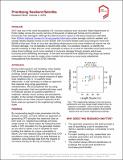| dc.contributor.author | Roxon, Jake | |
| dc.contributor.author | Pellenq, Roland | |
| dc.contributor.author | Ulm, Franz-Josef | |
| dc.date.accessioned | 2021-03-02T15:08:59Z | |
| dc.date.available | 2021-03-02T15:08:59Z | |
| dc.date.issued | 2018-02 | |
| dc.identifier.uri | https://hdl.handle.net/1721.1/130037 | |
| dc.description.abstract | 2017 was one of the most devastating U.S. hurricane seasons ever recorded. State Departments of Public Safety across the country list tens of thousands of destroyed homes and hundreds of thousands more damaged. Although the total economic impact is still being measured, estimates from NOAA’s National Centers for Environmental Information place damage costs for weather and climate related disaster events at over $300B, with hurricane-related costs accounting for more than $200B of that total. While it’s true that rebuilding infrastructure to be more resilient will reduce the risk of future damage, it is not feasible to rebuild entire cities. It is possible, however, to identify the specific buildings in cities that are most vulnerable to failure as a result of intensified wind loads and to make those buildings much more resistant to hurricane damage through already well-known hurricane-proof retrofitting techniques. In this brief we examine how additional long-range city texture parameters can be used to create urban models that enhance our previously established computational fluid dynamics (CFD) methods. | en_US |
| dc.relation.ispartofseries | MIT CSHub Research Brief; Volume 2018, Issue 2 | en_US |
| dc.subject | Retrofits | en_US |
| dc.subject | Hazards | en_US |
| dc.subject | Resilience | en_US |
| dc.subject | Hurricanes | en_US |
| dc.subject | Buildings | en_US |
| dc.title | Research Brief: Prioritizing Resilient Retrofits | en_US |
